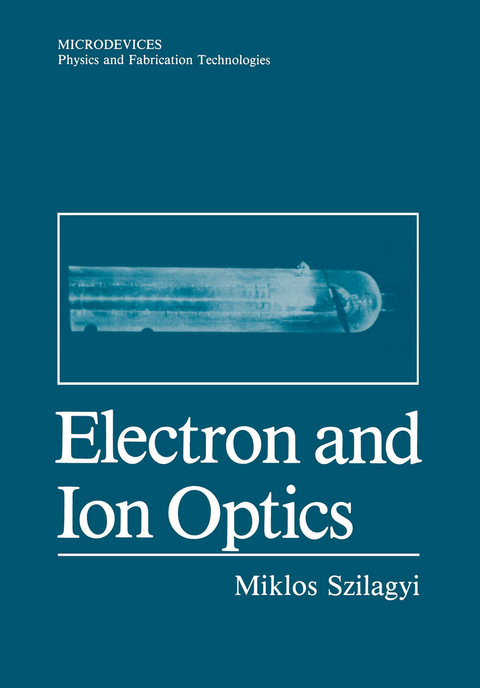
Electron and Ion Optics
Springer-Verlag New York Inc.
978-1-4612-8247-1 (ISBN)
The field of electron and ion optics is based on the analogy between geometrical light optics and the motion of charged particles in electromagnetic fields. The spectacular development of the electron microscope clearly shows the possibilities of image formation by charged particles of wavelength much shorter than that of visible light. As new applications such as particle accelerators, cathode ray tubes, mass and energy spectrometers, microwave tubes, scanning-type analytical instruments, heavy beam technologies, etc. emerged, the scope of particle beam optics has been exten ded to the formation of fine probes. The goal is to concentrate as many particles as possible in as small a volume as possible. Fabrication of microcircuits is a good example of the growing importance of this field. The current trend is towards increased circuit complexity and pattern density. Because of the diffraction limitation of processes using optical photons and the technological difficulties connected with x-ray processes, charged particle beams are becoming popular. With them it is possible to write directly on a wafer under computer control, without using a mask. Focused ion beams offer especially great possibilities in the submicron region. Therefore, electron and ion beam technologies will most probably playa very important role in the next twenty years or so.
1. Introductory Survey.- 1-1. Introduction.- 1-2. Electromagnetic Fields.- 1-3. Some Basic Classical Mechanics.- 1-4. A Little Reminder of Geometrical Optics.- Summary.- 2. Motion of Charged Particles in Electric and Magnetic Fields.- 2-1. The Lagrangian.- 2-2. Conservation of Energy.- 2-3. The Equations of Motion.- 2-4. The Trajectory Equations.- 2-5. The Relativistic Potential.- 2-6. The Electron Optical Index of Refraction.- 2-7. Particles in Homogeneous Fields.- Summary.- 3. Determination of Electric and Magnetic Fields.- 3-1. Analytical Methods.- 3-2. Measurement of Fields and Analog Methods.- 3-3. Numerical Methods.- Summary.- 4. Focusing With Axially Symmetric Fields.- 4-1. Busch’s Theorem.- 4-2. The General Trajectory Equation.- 4-3. The Paraxial Ray Equation.- 4-4. Image Formation by Paraxial Rays.- 4-5. The Helmholtz-Lagrange Formula.- 4-6. Cardinal Elements.- 4-7. Electron and Ion Lenses.- 4-8. Systems of Lenses.- 4-9. The Thin-Lens Approximation.- 4-10. Examples of Paraxial Focusing.- Summary.- 5. The Theory of Aberrations.- 5-1. The Method of Characteristic Functions.- 5-2. Geometrical Aberrations.- 5-3. Chromatic Aberration.- 5-4. Asymptotic Aberrations.- 5-5. Aberrations of Lens Combinations.- 5-6. Other Sources of Aberrations and Aberration Correction.- 5-7. Simultaneous Action of Different Aberrations.- Summary.- 6. Numerical Techniques for Ray Tracing and Calculation of Aberrations.- 6-1. Analytical Models.- 6-2. Numerical Ray Tracing.- 6-3. Numerical Calculation of Aberration Integrals.- Summary.- 7. Electrostatic Lenses.- 7-1. General Properties and Relationships.- 7-2. Electrostatic Lens Models.- 7-3. Two-Electrode Immersion Lenses.- 7-4. Unipotential Lenses.- 7-5. Three-Electrode Immersion Lenses.- 7-6. Multielectrode Lenses.- 7-7. Comparison ofDifferent Electrostatic Lenses.- 7-8. Lenses Immersed in Fields.- Summary.- 8. Magnetic Lenses.- 8-1. General Properties and Relationships.- 8-2. Long Lenses.- 8-3. Magnetic Lens Models.- 8-4. Short Lenses.- Summary.- 9. Computer-Aided Optimization and Synthesis of Electron and Ion Lenses.- 9-1. Is Aberrationless Electron/Ion Optics Possible?.- 9-2. Optimization: Synthesis versus Analysis.- 9-3. Early Attempts of Synthesis.- 9-4. Calculus of Variations.- 9-5. Dynamic Programming.- 9-6. Optimal Control Procedure.- 9-7. Analytical Functions.- 9-8. Reconstruction of Electrodes and Pole Pieces from the Optimized Axial Field Distributions.- 9-9. Polynomial and Spline Lenses.- 9-10. The Synthesis Procedure.- 9-11. Artificial Intelligence Techniques.- Summary.- 10. Multipole Lenses.- 10-1. The Fields of Multipole Lenses.- 10-2. The Paraxial Ray Equations.- 10-3. Image Formation by Paraxial Rays.- 10-4. Systems of Quadrupoles.- 10-5. Aberrations of Multipole Lenses.- Summary.- 11. Beam Deflection.- 11-1. Deflection for Scanning.- 11-2. Electrostatic and Magnetic Prisms.- 11-3. New Symmetries-New Possibilities.- Summary.- 12. High-Intensity Beams.- 12-1. Space-Charge Optics.- 12-2. The Boersch Effect.- Summary.- References.
| Reihe/Serie | Microdevices |
|---|---|
| Zusatzinfo | 556 p. |
| Verlagsort | New York, NY |
| Sprache | englisch |
| Maße | 170 x 244 mm |
| Themenwelt | Sachbuch/Ratgeber ► Natur / Technik ► Garten |
| Technik ► Elektrotechnik / Energietechnik | |
| Technik ► Maschinenbau | |
| ISBN-10 | 1-4612-8247-0 / 1461282470 |
| ISBN-13 | 978-1-4612-8247-1 / 9781461282471 |
| Zustand | Neuware |
| Haben Sie eine Frage zum Produkt? |
aus dem Bereich


